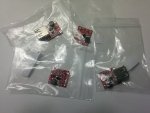rhd
0
- Joined
- Dec 7, 2010
- Messages
- 8,469
- Points
- 0
Is anyone familiar with Attiny13 programming and willing to give me a half hour or so of time in exchange for.... I don't know, something laser related, or some money?
I basically want:
- to have someone covert a program that I'll write in basic generic code (consisting mostly of if/then logic, a button press, a single memory read/write, generation of a random number, output on a couple pins, and then, perhaps the only tricky part, generation of a pwm signal with a couple different duty cycles)
- the ability to ask some questions along the way, so I can fast track my own process of getting up and running to program chips.
I basically want:
- to have someone covert a program that I'll write in basic generic code (consisting mostly of if/then logic, a button press, a single memory read/write, generation of a random number, output on a couple pins, and then, perhaps the only tricky part, generation of a pwm signal with a couple different duty cycles)
- the ability to ask some questions along the way, so I can fast track my own process of getting up and running to program chips.





